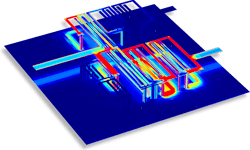Designers Find the Right Code at IMS 2017
The IMS exhibition has long been a showcase for the latest RF/microwave software simulation tools, and the 2017 event continues that trend with some of the most trusted programs in the industry available for demonstrations on the exhibition show floor.
Simulation software has become a starting point for many RF/microwave designers, given the high quality and accuracy of the many design tools currently available. Representatives from the AWR group of National Instruments, for example, will be on hand at booth No. 740 to discuss recent success stories based on the company’s popular Microwave Office simulation and design software suite.
In addition, AWR’s technical presenters will be busy from start to finish, with several MicroApps (in booth No. 1047) early in the week on millimeter-wave design techniques and methods for developing antenna beam-steering solutions and multiple-input, multiple-output (MIMO) antenna arrays. Later in the week, AWR’s Dr. Derek Linden will present a two-hour antenna workshop on how to design and build an HDTV antenna from readily available materials such as coaxial cable and cardboard.
The MathWorks will be at booth No. 1758 to show how to apply MATLAB for the design of millimeter-wave passive circuits and components, such as antennas and couplers (Fig. 1). Computer Simulation Technology (CST) was at booth No. 1332 to help designer explore its suite of EM simulation tools, including Antenna Magus for antenna architects.
In addition to a full lineup of microwave and millimeter-wave signal generators and analyzers, Keysight Technologies will be at booth No. 848 with a comprehensive collection of design and simulation software tools for RF/microwave designers. The lineup includes the Advanced Design System (ADS) for device and circuit designers, the EMPro three-dimensional (3D) electromagnetic (EM) simulation software, the Momentum 3D planar EM simulation software, and the SystemVue system-level simulation software. All provide designers of commercial and military electronic systems the opportunity to see the impact of mechanical and electrical component changes on overall system performance.
Visitors to the 2017 IMS exhibition who are interested in EM simulation software would be remiss not to check out Version 16 of the Sonnet Software EM simulation software (Fig. 2), a helpful tool for designing microwave printed-circuit boards (PCBs). The software can take into account the effects of different dielectric materials and different conductor surface finishes, precisely predicting the coupling effects and losses for all commonly used transmission-line technologies, including microstrip, stripline, and coplanar-waveguide (CPW) transmission lines.


